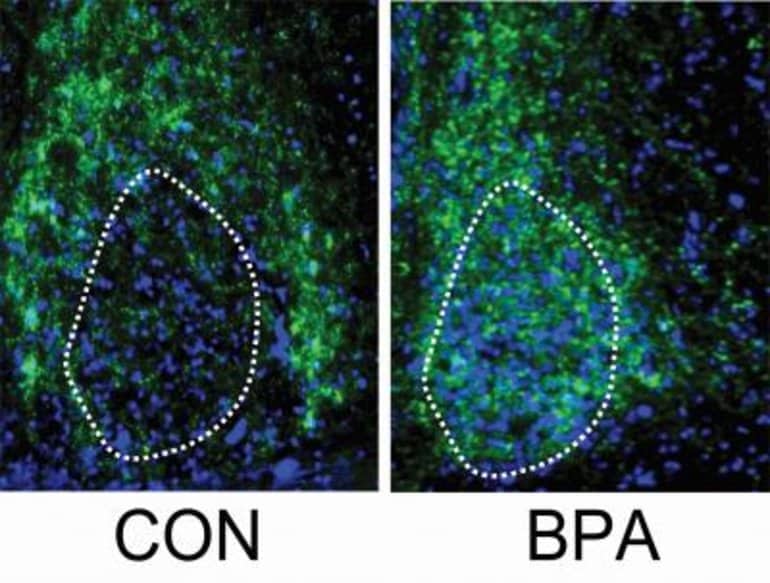Summary: A new mouse study reveals that exposure to BPA at levels 25 times lower than deemed safe has an impact on brain development.
Source: University of Calgary
Humans are exposed to a bath of chemicals every day. They are in the beds where we sleep, the cars that we drive and the kitchens we use to feed our families. With thousands of chemicals floating around in our environment, exposure to any number is practically unavoidable. Through the work of researchers like Dr. Deborah Kurrasch, PhD, the implications of many of these chemicals are being thoroughly explored.
“Manufacturers follow standards set by regulatory bodies, it’s not up to the manufacturers to prove the chemicals in consumer products are safe,” says Kurrasch, a researcher in the University of Calgary’s Hotchkiss Brain Institute (HBI) and Alberta Children’s Research Institute at the Cumming School of Medicine. “Scientists play a critical role and do the meticulous work of determining where the risks lie.”
Kurrasch’s research over the past decade has focused on a chemical that is broadly recognizable: Bisphenol A, also known as BPA. This chemical is commonly found in plastics, canned food linings, and even thermal receipts. Studies from Kurrasch’s lab contribute to the collective research that shows the harms of exposure to this industrial compound.
The latest study out of Kurrasch’s lab, published in Science Advances, suggests that continued vigilance is needed. A postdoctoral researcher in her lab, Dr. Dinu Nesan, PhD, examined the impact of low levels of BPA exposure to pregnant mice and the brain development of their offspring.
“Our goal was to model BPA levels equivalent to what pregnant women and developing babies are typically exposed to,” says Kurrasch. “We purposefully did not use a high dose. In fact, our doses were 11-times and nearly 25-times lower than those deemed safe by Health Canada and the FDA (U.S. Food and Drug Administration), respectively. Even at these low levels, we saw effects on prenatal brain development in the mice.”
Using this BPA exposure model, Nesan found striking changes to the brain region responsible for driving circadian rhythms, the suprachiasmatic nucleus, located in the hypothalamus. When prenatally exposed to these low levels of BPA, the suprachiasmatic nucleus failed to develop properly. This change can have implications for sleep, activity levels, and other behaviours.
“Previously we showed embryonic exposure to low-dose BPA can affect the timing of when neurons develop in zebrafish, but it was unclear whether a similar effect would be observed in a mammalian model with more similarities to humans,” says Nesan, first author on the study.
When neurons develop, they rely on proper signals to guide them. If neurons develop too early, the cues they experience are different, which can lead to developmental errors such as migrating to the wrong location, becoming the wrong type of neuron, or forming inappropriate connections. These errors can lead to altered behaviors later in life.

“Our study shows that in pregnant mice, prenatal exposure to BPA affects the timing of neuron development in the fetal brain, which has lasting effects on behaviours. Offspring that are exposed to BPA during gestation are awake longer and exhibit hyperactivity. The prenatal BPA exposure seems to change the brain’s circadian cues, causing the animals to have elevated energy levels and spend less time resting,” says Nesan.
The researchers are hopeful their findings will add continued pressure on regulatory bodies to keep revisiting their determinations around safe levels of BPA.
“We think there’s an incredible abundance of data showing BPA exposure guidelines are not yet at the appropriate level, which includes even the EU (European Union) who is leading on this front, but their ‘safe’ levels are still twice the dose we used in our study” says Kurrasch, “We hope our research serves as a reminder that low dose BPA is still capable of causing changes that are measurable and significant.”
Her message of how to interpret this research is simple:
- Limit your exposure to BPA the best you can.
- Maintain smart practices with plastics in your kitchen, for example not heating them, and using glass or stainless steel when possible.
This research was conducted in collaboration with Dr. Michael Antle, PhD, professor of psychology and member of the HBI.
About this neurodevelopment research news
Source: University of Calgary
Contact: Kelly Johnston – University of Calgary
Image: The image is credited to Kurrasch lab, published in Science Advances
Original Research: Open access.
“Gestational low-dose BPA exposure impacts suprachiasmatic nucleus neurogenesis and circadian activity with transgenerational effects” by Deborah Kurrasch et al. Science Advances
Abstract
Gestational low-dose BPA exposure impacts suprachiasmatic nucleus neurogenesis and circadian activity with transgenerational effects
Critical physiological processes such as sleep and stress that underscore health are regulated by an intimate interplay between the endocrine and nervous systems.
Here, we asked how fetal exposure to the endocrine disruptor found in common plastics, bisphenol A (BPA), causes lasting effects on adult animal behaviors.
Adult mice exposed to low-dose BPA during gestation displayed notable disruption in circadian activity, social interactions, and associated neural hyperactivity, with some phenotypes maintained transgenerationally.
Gestational BPA exposure increased vasopressin+ neurons in the suprachiasmatic nucleus (SCN), the region that regulates circadian rhythms, of F1 and F3 generations. Mechanistically, BPA increased proliferation of hypothalamic neural progenitors ex vivo and caused precocious neurogenesis in vivo.
Co-antagonism of both estrogen and androgen receptors was necessary to block BPA’s effects on hypothalamic neural progenitors, illustrating a dual role for these endocrine targets.
Together, gestational BPA exposure affects development of circadian centers, with lasting consequences across generations.







